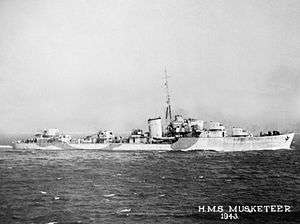HMS Musketeer (G86)
 Musketeer underway | |
| History | |
|---|---|
| Name: | HMS Musketeer |
| Ordered: | 7 July 1939 |
| Builder: | Fairfield Shipbuilding and Engineering Company, Govan, Scotland |
| Laid down: | 2 December 1940 |
| Launched: | 4 September 1941 |
| Completed: | 18 September 1942 |
| Fate: | Sold for scrap 3 September 1955 |
| Notes: | pennant number: G86 |
| General characteristics (as built) | |
| Class and type: | M-class destroyer |
| Displacement: | |
| Length: | 362 ft 3 in (110.4 m) (o/a) |
| Beam: | 37 ft (11.3 m) |
| Draught: | 14 ft (4.3 m) |
| Installed power: |
|
| Propulsion: |
|
| Speed: | 36 knots (67 km/h; 41 mph) |
| Range: | 5,500 nmi (10,200 km; 6,300 mi) at 15 knots (28 km/h; 17 mph) |
| Complement: | 190 |
| Sensors and processing systems: | |
| Armament: |
|
HMS Musketeer was a M-class destroyer built for the Royal Navy during World War II. She was ordered from Fairfield's, Govan, Glasgow on 7 September 1939 under the 1939 Build Programme and laid down on 7 December the same year. She was launched on 2 December 1941 and completed on 18 September 1942 at a cost of £462,543. Musketeer was adopted in December 1941 by the community of East Barnet, now part of Greater London. Musketeer was the second RN ship to carry this name: the first was a destroyer built in 1919 and sold in 1921.
Service
Arctic Convoys
Musketeer commissioned on 9 September 1942 and joined the Home Fleet as part of the 3rd Destroyer Flotilla covering the North Sea and the North Western Approaches. In November 1942 she was switched to duty with the convoys to the Soviet Union, protecting merchant shipping delivering vital supplies to Russia for her war against Nazi Germany. This was a role that Musketeer was to perform for most of her wartime service, although from May to September 1943, following a refit, she once again served in the Home Fleet guarding the Western Approaches. On 27 September 1943 she took part in a mission in support of Royal Air Force (RAF) attempts to neutralise the German battleship Tirpitz, when she ferried RAF personnel from the Faroe Islands to Murmansk. Murmansk was the base for reconnaissance flights to Tripitz's anchorage in the Altafjord in Norway. These flights were used in the planning of an eventual RAF bombing raid on the battleship. On 25 February 1944 Musketeer was involved in a collision with the Polish destroyer ORP Błyskawica, breaking off from convoy duty to be taken in hand for repair by Brigham and Cowan shipyard in Hull. Repairs were completed by the end of March 1944 and in early April the ship was again back on Russian convoy duty.
Mediterranean
On 3 October 1944, Musketeer was assigned for service in the Eastern Mediterranean. She worked mainly in the Aegean supporting the re-capture of enemy-held islands and operating against the small Greek Communist ships of the ELAN. Following VE day in May 1945 Musketeer continued her service in the Mediterranean and helped in the support of the garrisons in Trieste and mainland Greece.
References
- Colledge, J. J.; Warlow, Ben (2006) [1969]. Ships of the Royal Navy: The Complete Record of all Fighting Ships of the Royal Navy (Rev. ed.). London: Chatham Publishing. ISBN 978-1-86176-281-8. OCLC 67375475.
- English, John (2001). Afridi to Nizam: British Fleet Destroyers 1937–43. Gravesend, Kent: World Ship Society. ISBN 0-905617-64-9.
- Friedman, Norman (2006). British Destroyers & Frigates: The Second World War and After. Annapolis, Maryland: Naval Institute Press. ISBN 1-86176-137-6.
- Lenton, H. T. (1998). British & Empire Warships of the Second World War. Annapolis, Maryland: Naval Institute Press. ISBN 1-55750-048-7.
- March, Edgar J. (1966). British Destroyers: A History of Development, 1892-1953; Drawn by Admiralty Permission From Official Records & Returns, Ships' Covers & Building Plans. London: Seeley Service. OCLC 164893555.
- Rohwer, Jürgen (2005). Chronology of the War at Sea 1939-1945: The Naval History of World War Two (Third Revised ed.). Annapolis, Maryland: Naval Institute Press. ISBN 1-59114-119-2.
- Whitley, M. J. (1988). Destroyers of World War 2. Annapolis, Maryland: Naval Institute Press. ISBN 0-87021-326-1.
External links
| Wikimedia Commons has media related to HMS Musketeer (G86). |